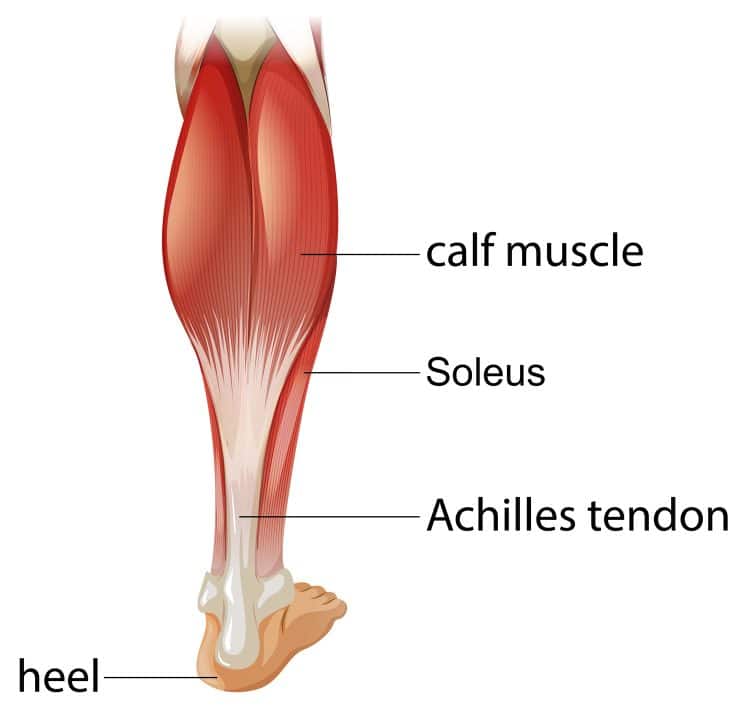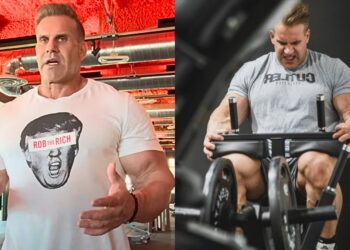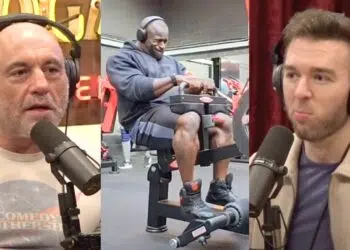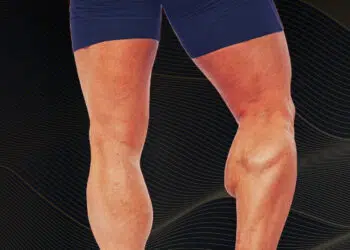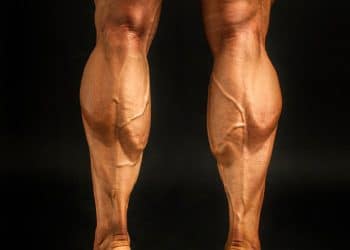When it comes to calf training, most people focus their attention on the gastrocnemius, the most prominent muscle in the lower legs. However, there is another muscle that makes up the calf, and it’s called the soleus.
The soleus muscle is larger and potentially stronger than its more popular counterpart. While the two calf muscles mostly work together, the soleus can be emphasized.
As a personal trainer with over 35 years of experience, I can attest that most people have tiny calves because they overlook soleus training. In this article, I reveal the eight best exercises to strengthen and stretch the often-overlooked soleus muscle.
Recent Updates: On June 10, 2024, Fitness Volt’s Senior Editor, Vidur Saini (American Council on Exercise-CPT), updated the article and added actionable expert tips throughout the piece to improve the reader experience.
Level Up Your Fitness: Join our 💪 strong community in Fitness Volt Newsletter. Get daily inspiration, expert-backed workouts, nutrition tips, the latest in strength sports, and the support you need to reach your goals. Subscribe for free!
8 Top Soleus Strengthening and Stretching Exercises
Whether you want to build more muscular calves, run faster, jump higher, or improve ankle mobility for deeper squats, these are the best strengthening and stretching exercises!
- Seated Calf Raise Machine
- Seated Calf Raise With Free-Weights
- Soleus Bridge
- Soleus Squat
- Standing Soleus Stretch
- Kneeling Soleus Stretch
- Bent-Knee Self-Assisted Soleus Stretch
- Foam Rolling The Soleus
1. Seated calf raise machine
| Sets & Reps | Equipment Needed | Target Muscles |
| 3 x 10-15 | Seated calf raise machine | Soleus, gastrocnemius (bias towards soleus) |
Seated calf raises are done with bent knees, putting slack into your gastrocnemius and leaving your soleus to do more of the work. Most gyms have a seated calf raise machine, and you should make this exercise the cornerstone of your calf workouts if you want to develop bigger, stronger soleus muscles.
“Instead of focusing on simply lifting the weight, drive your big toes into the platform on the lifting phase to emphasize the medial head of the gastrocnemius,” says Saini.
How to do it:
- Sit on the machine and place the balls of your feet on the edge of the footrest. Your shins should be roughly vertical. Rest the leg restraint on your lower thighs.
- Release the weight and then smoothly lower your heels down below your toes. Get a good stretch in your calves.
- Then, without leaning backward or using your arms for assistance, push up onto your tiptoes and pause for 1-2 seconds.
- Lower your heels and repeat.
Pro Tip: Studies suggest that the soleus comprises primarily slow-twitch muscle fibers and responds best to light weights and high reps (1). So, do low reps and heavy weights for your gastrocnemius and use the opposite approach for training your soleus to maximize hypertrophy.
2. Seated calf raise with free-weights
| Sets & Reps | Equipment Needed | Target Muscles |
| 3 x 8-12 | Dumbbells, weight plate, or barbell | Soleus, gastrocnemius (bias towards soleus) |
No seated calf machine at your gym? No problem! You can also work your soleus with a barbell or dumbbells. That’s good news for anyone who trains in a poorly equipped gym or prefers to work out at home.
Saini recommends using a slow and controlled eccentric phase to increase the time under tension (TUT) and promote hypertrophy.
How to do it:
- Sit on a chair with your knees bent to around 90 degrees. Place the balls of your feet on a three to six-inch high platform, such as a small box, step, or stack of weight plates. Your shins should be roughly vertical.
- Rest a barbell or dumbbells on your lower thighs and hold them in position. You can also use kettlebells or any other weighty object. Place a folded towel under the weight for comfort if necessary.
- Plantar flex your ankles and rise up as high as possible on your tiptoes. Pause for 1-2 seconds.
- Then, smoothly lower your heels down and get a good stretch in your calves. Lift and lower your heels for the required number of reps.
- You can also do this exercise using one leg at a time which may be useful if you want to get a stronger mind-muscle connection or don’t have enough weight to overload both legs at the same time.
Pro Tip: Experiment with different foot placements (toes in, toes out, neutral) to target different parts of the calf complex. Each variation stimulates unique muscle fiber orientations, promoting comprehensive growth.
3. Soleus bridge
| Sets & Reps | Equipment Needed | Target Muscles |
| 3 x 15-20 | Bodyweight | Soleus |
Ultimately, your body cannot tell if you are doing seated calf raises on a selectorized machine or are sitting on an old dining room chair with a bag of books resting on your knees. That’s good news because it means you can train your calves using any form of overload, even your body weight.
This simple exercise is a great way to train your soleus at home. As an added benefit, it’ll also fire up your glutes and hamstrings.
How to do it:
- Lie on your back with your legs bent. Place the balls of your feet on a low step, so your heels are free to move. Push your hips up to load your calf muscles.
- Without flexing your hips, push down through the balls of your feet and rise up onto your tiptoes. Pause for 1-2 seconds.
- Next, lower your heels down and get a good stretch in your calves.
- Lift and lower your heels for the required number of reps.
- You can also do this exercise using one leg at a time to put more weight on your calves.
Pro Tip: Keep your glutes engaged throughout the movement to improve stability and magnify calf contractions.
4. Soleus squat
| Sets & Reps | Equipment Needed | Target Muscles |
| 3 x 8-12 | Bodyweight | Soleus, gastrocnemius |
Are you short on time? Do you want to train your quads and your calves simultaneously? Then you need to try the soleus squat! Besides being a total leg exercise, this move will improve your balance and mobility and build ankle stability.
It’s essential to prioritize muscle contractions over speed in this exercise, chimes in Saini.
How to do it:
- Stand with your feet about hip-width apart, toes pointing forward. Rise up onto your tiptoes.
- Without lowering your heels, bend your legs and squat down as deeply as possible. Pause for 1-2 seconds.
- Drive the balls of your feet into the floor and stand back up. Try not to lower your heels to the floor between reps.
- Reduce the balance component of this exercise so you can really focus on your calves by doing this exercise with support, e.g., holding onto a handrail or squat rack.
Pro Tip: Maintain a slight dorsiflexion (toes pointing up) at the bottom of the squat to ensure the soleus remains under tension throughout the entire range of motion (ROM).
5. Standing soleus stretch
| Sets & Reps | Equipment Needed | Target Muscles |
| 2 x 30s hold | Bodyweight | Soleus |
A tight soleus will limit the range of motion of your ankle joint. This can increase your risk of calf injuries during high-impact activities like running, sprinting, and jumping. Also, tight calves can reduce squat depth, preventing you from moving your knees forward over your toes. If you want to squat “ass to grass,” you need flexible calves and mobile ankles!
As such, you should do exercises to strengthen your soleus and stretch it, too. The standing soleus stretch is both simple and effective.
How to do it:
- Stand facing a wall and place your hands against it at about shoulder height. Adopt a staggered stance with one foot in front of the other.
- Bending both legs slightly for balance, sink down on your rear leg, and push your knee forward while keeping your heel flat on the floor.
- You should feel a deep stretch in the lower part of your calf and Achilles tendon.
- Hold for 15-30 seconds, and then swap sides.
- Get a deeper stretch by placing a weight plate under the ball of the foot on the side you’re working.
Level Up Your Fitness: Join our 💪 strong community in Fitness Volt Newsletter. Get daily inspiration, expert-backed workouts, nutrition tips, the latest in strength sports, and the support you need to reach your goals. Subscribe for free! Pro Tip: For a deeper soleus stretch, slightly internally rotate your hip (turn your knee inwards) as you lean forward.
6. Kneeling soleus stretch
| Sets & Reps | Equipment Needed | Target Muscles |
| 2 x 30s hold | Bodyweight | Soleus |
The soleus muscle can be very resistant to stretching. It’s a strong muscle that often needs to be quite forcefully extended. This exercise uses your entire body weight to stretch your soleus, making it ideal for stubborn calves. However, you should only do this exercise once you are well warmed up and avoid bouncing, which could damage the soleus or Achilles tendon.
Saini added that this stretch can be particularly beneficial for individuals with tight ankles or limited dorsiflexion.
How to do it:
- Adopt a half-kneeling position, so your rear knee is next to your front heel. Rest your forearms on your front knee.
- Shift your weight forward and push your front knee out in front of your toes until you feel a deep stretch in the lower part of your calf and Achilles tendon. Keep your front heel pressed firmly into the floor.
- Hold for 15-30 seconds, and then swap sides.
Pro Tip: Keep your core braced to maintain a neutral spine during the stretch to prevent excessive lumbar flexion.
7. Bent-knee self-assisted soleus stretch
| Sets & Reps | Equipment Needed | Target Muscles |
| 2 x 30s hold | Wall or other sturdy object | Soleus |
If you’re coming back from a calf injury, the last thing you must do is stretch too aggressively. This exercise doesn’t use body weight to stretch your soleus, making it far gentler and ideal for anyone rehabbing a calf injury or who prefers a less intense stretch. You could also use it as a warm-up before doing more intense soleus stretching exercises.
“Don’t force this stretch beyond your comfortable range of motion, as it can lead to injury,” says Saini. “Instead, focus on gradual progression and hold the stretch at a point of mild tension for optimal results.”
How to do it:
- Sit on the floor with your legs extended in front of you. Take the stress out of your hamstrings by sitting on a low step or block if necessary. Bend your knees to slacken your calves and take the gastroc out of the exercise.
- Loop a belt or yoga strap over the balls of your feet. You can also use a strong resistance band.
- Gently pull on the strap/band to bring the balls of your feet toward your shins until you feel a mild stretch in your calves and Achilles tendon.
- Hold for 15-30 seconds, and then relax.
Pro Tip: Keep your heel grounded throughout the stretch to maximize the stretch.
8. Foam rolling the soleus
| Sets & Reps | Equipment Needed | Target Muscles |
| 2 x 30s/leg | Foam roller | Soleus, gastrocnemius (self-massage) |
Your muscles are surrounded by a thin layer of fibrous tissue called fascia. Fascia separates and connects each muscle from its neighbor. This fascia can become “gummed up,” leading to tight, painful muscles. This can cause trigger points, poor blood flow, and reduced function.
Foam rolling is a form of self-massage called self-myofascial release that can help free up your fascia and restore normal movement and function. Foam rolling your calves will enhance your flexibility and performance.
How to do it:
- Sit on the floor with your legs extended in front of you. Place your foam roller under one calf. Support your weight on your hands.
- Lifting your butt off the floor, move your leg forward and back to roll along your calf. Rotate your hip in and out to hit both sides of your soleus.
- Seek out any areas of tightness and spend a little longer working on them until they start to diminish.
- Increase the pressure by crossing your other leg over the one you’re treating.
- Continue for 2-4 minutes, and then swap sides.
Pro Tip: Foam rolling can be painful. But, as the adhesions start to dissolve, subsequent foam rolling sessions should be less uncomfortable. Increase the pressure gradually to avoid unnecessary pain.
Best Soleus Workout
Add the following workout to your arsenal:
| Exercise | Sets | Reps | Rest |
| Seated Calf Raise Machine | 3 | 10-15 | 60 seconds |
| Soleus Bridge | 3 | 15-20 | 30 seconds |
| Seated Calf Raise with Free Weights | 3 | 8-12 | 60 seconds |
| Soleus Squat | 3 | 8-12 | 60 seconds |
| Foam Rolling the Soleus | 2 | 30 seconds per leg | 60 seconds |
Calf Anatomy
The calves are easy to ignore. After all, they’re way down at the bottom of your leg, so they’re often out of sight and out of mind. However, when well-developed, the calves can add a lot to your physique, especially if you wear shorts!
There are several muscles that make up the calf complex, which is often called the triceps surae, referring to the three different muscle heads that make up this body part.
The calf muscles are:
Gastrocnemius
The gastrocnemius is the dual-headed outermost calf muscle that makes up most of your lower leg girth. The gastroc is a biaxial muscle, meaning it crosses two joints — the ankle and the knee. As such, it has two primary functions.
The main role of the gastrocnemius is plantar flexion of the ankle. This means pointing your toe, as happens during calf raises.
The second function of the gastrocnemius is knee flexion. It works with the hamstrings to help bend your knees. Watch your calves during leg curls to see them contract to aid your hamstrings. However, this is quite a weak action compared to plantar flexion.
Soleus
The second main calf muscle, the soleus, lies beneath the gastrocnemius, and only the lower section is really visible. Unlike the gastroc, the soleus is a uniaxial muscle that only crosses one joint; the ankle.
As such, the soleus only has one main function — plantarflexion.
While soleus and gastrocnemius work together, it is possible to emphasize the soleus by working with bent knees. When your knees are bent, the gastrocnemius is put into a semi-relaxed position and cannot contribute as much to plantar flexion.
So, if you want to train both calf muscles, exercises like straight leg calf raises and donkey calf raises are the way to go. But, if you want to deemphasize the gastroc and hit the soleus a little more, bent-knee exercises are more effective.
Wrapping Up
While the soleus is largely hidden behind the gastrocnemius, it’s no less important for calf size and strength. You train your soleus every time you work your gastrocnemius, but that doesn’t mean it won’t benefit from some individual attention from time to time.
Use these strengthening and stretching exercises to keep your soleus in tip-top condition. Whether you want bigger, stronger calves or want to run faster, or jump higher, your soleus deserves your attention!
References:
1- Springer.com: Human soleus muscle: A comparison of fiber composition and enzyme activities with other leg muscles https://link.springer.com/article/10.1007/BF00587415

